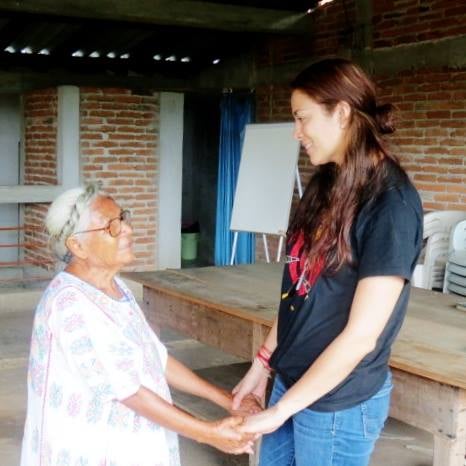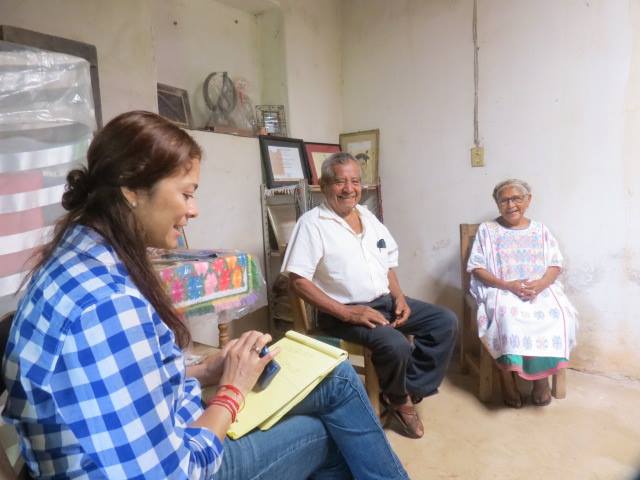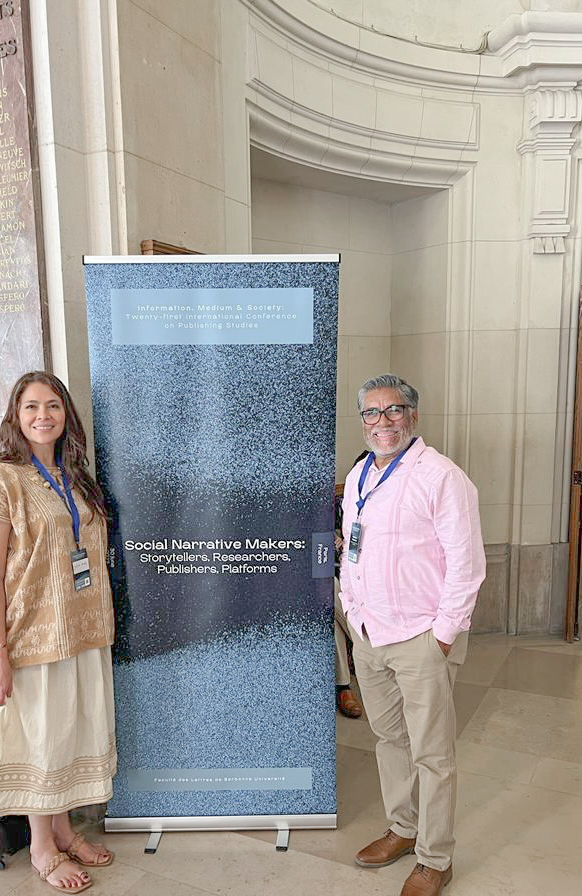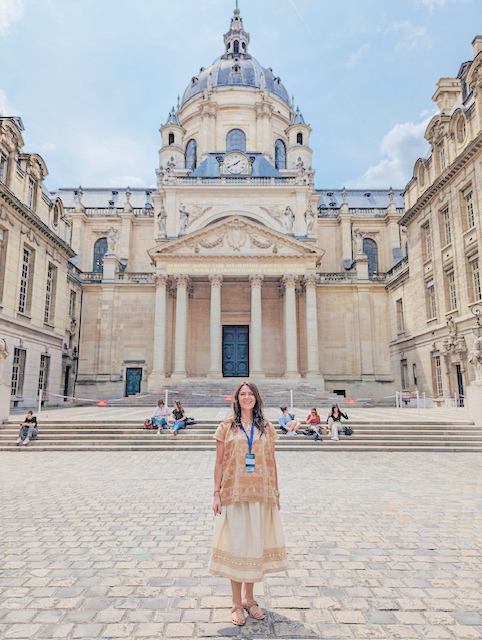PARIS, France, July 20, 2023—Lynnwood City Councilwoman Dr. Julieta Altamirano-Crosby, just returned from Paris where she presented on the life and work of Florentina López de Jesús, an indigenous Amuzgo artist, for Paris-Sorbonne University’s Cultural Preservation through Indigenous Storytelling conference.

The three-day conference, spanning from June 28 through June 30, was hosted by Information, Medium, and Society – The Publishing Studies Research Network, in its twenty-first annual international conference. Next year’s event is scheduled to be in Rome, Italy.
Councilwoman Dr. Altamirano-Crosby emphasized she paid for the trip out-of-pocket and did not receive any of the city’s funds, nor requested reimbursement for travel expenses.

The Publishing Studies Research Network was founded in 2003 with the inaugural International Conference on the Future of the Book. Since its founding, the Research Network has expanded its scope in two phases; The first in 2009 when it became Books, Publishing, and Libraries Research Network, looking beyond the book as the primary site of investigation. In 2019 the network underwent another change; to become the Information, Medium & Society.
Dr. Altamirano-Crosby submitted an outline of her presentation last year, when the network opened their application process, and was notified on August 11, 2022, that her topic had been accepted. In its acceptance letter the network stated: “we believe that your presentation and participation in general discussions will make a significant contribution to the conference.”
Cultural Preservation through Indigenous Storytelling: Alternatives to So-called Paternalistic “Scholarly” Ethnographies Abstract: “White ethnographers, anthropologists, and sociologists have dominated the historical and cultural narratives about Indigenous cultures in North America, often citing autonomous “informants.” Regardless of how sincere these narratives may seem, they are all too often presented through ethnocentric lens. Often these narratives are too widely classified by geographic or linguistic terms – therefore missing the intricate details put forth by the Indigenous storyteller. Our study focuses on the life and work of Florentina (“Tina”) Lopez de Jesus (1939-2014), an Amuzga Indigenous in Xochistlahuaca in the Costa Chica region of Guerrero State, Mexico. Her remarkable storytelling, conveyed through her aboriginal weaving skills, told the story of the often-forgotten Amuzga and their affiliation with the pre-Aztec, Mixtec civilization. She articulated the rich pre-Columbian arts of natural dyes, fibber’s, and weaving that is often associated with other Indian groups without due credit to her group. Fortunately, recognition for her work went beyond her region and Mexico leading to International recognition, including the 2001 UNESCO Handcrafts Prize. Her oral history of the Amuzga was conveyed to fellow Indian scholars who share her cultural heritage – notably, Juieta Altamirano-Cosby. Contrasts are made with other “scholarly” assessments of the tribes of this region as well as awareness of the problem of biases inherent in ethnocentric scholarship.”
Joined by colleagues Laurence French, Affiliate Professor of the College of Liberal Arts at University of New Hampshire, and Magdaleno Manzanárez, Vice President and Professor, and External Affairs at Western New Mexico University, the team presented on a subject near and dear to the Lynnwood City Councilwoman’s heart: Florentina López de Jesús, who Altamirano-Crosby had the pleasure of working closely with before her passing in 2014.

López de Jesús was a traditional Amuzgo weaver from Xochistlahuaca, Guerrero, Mexico – where Altamirano-Crosby is also from. She was born into a poor Amuzgo family in Xochislahuaca, in the Costa Chica region and, like most Amuzgo girls, she learned to weave cotton garments at a young age by watching and imitating her mother.
When López de Jesús was fourteen, she went to work as a maid to help with her family’s finances. While working here, she got the idea of selling her artwork in nearby Ometepec to help support her family – thus beginning her career as a professional weaver.
López’s work quickly caught the attention of government agency FONART, through which she sold her art from 1969 and 1971. López was involved in the artistic process from start to finish, growing her own cotton, dying it with plants and minerals from her area, and seeing the project through to its completion. She attended several seminars to learn more about natural dyes while mastering various weaving techniques such as taffeta, simple weave, taletón (a variation of taffeta) and variations of gauze.
López specialized in a type of weaving called “brocade” in white and coyuche (a local brown variation) cotton with the design woven in using variously colored weft threads. In addition to traditional huipils, she produces napkins, tablecloths, rebozos and bedspreads. By special order, she has also made garments with other fibers such as silk and synthetics.

López’s work has won a number of awards including second place Gran Premio de Arte Popular, FONART in 1987, first place Gran Premio de Arte Popular, FONART in 1991 and Premio Nacional de Artesanias de SECOFI in 1993. In 2001 she won the UNESCO Handcrafts Prize. Also, on October 27, 2013, she was awarded the Antonia Nava de Catalán Female Merit Award and was considered one of the Eight Powerful and Glamorous Women in 2013 by the Milenio newspaper.
Separate to her artwork, López was deeply embedded in her community, even serving as a City Councilwoman in her native town. Every summer she would provide free weaving courses for young girls, and in 1989 was instrumental in the creation of the El Porvenir Elementary School, a government backed bi-lingual inter-cultural school designed to strengthen pride in one’s roots, enriching the official curriculum.
Altamirano-Crosby first met López de Jesús in 2000 while working on her dissertation for her Bachelor’s Degree in Social Communications. Wanting to focus on impactful artists, she stumbled upon López de Jesús’ work, then drove to her house and knocked on her door to meet her personally. Through researching her life, the two became close friends until López de Jesús died from a heart attack at the age of 74.

“She was an amazing woman and an amazing leader,” Altamirano-Crosby told the Lynnwood Times. “She created a legacy passed on to young people and women to stand up for their rights…I was really close to her, and close to her family, so it was a very big loss [when she passed].”
Altamirano-Crosby played a pivotal role in getting López de Jesús’ work recognized at many art exhibitions including the Mexican Museum of Art in Chicago, and told the Lynnwood Times she decided to present on Lopez de Jesus’ legacy in Paris because she “felt like [she] owed it to her.”
“I want her to be recognized and I want people to know who she was,” said Altamirano-Crosby. “
Council Vice President Dr. Altamirano-Crosby is currently working on writing a book about López de Jesús’ life she hopes will be used at colleges for educational purposes. She anticipates the book will be completed next year and also plans to organize an art exhibit of López de Jesús’ work some time before then.
Author: Kienan Briscoe








